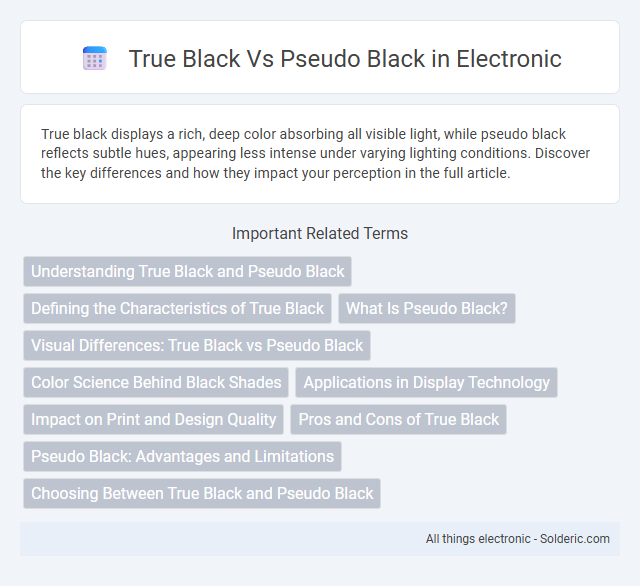True black displays a rich, deep color absorbing all visible light, while pseudo black reflects subtle hues, appearing less intense under varying lighting conditions. Discover the key differences and how they impact your perception in the full article.
Comparison Table
| Feature | True Black | Pseudo Black |
|---|---|---|
| Definition | Absolute black with no light emission or reflection | Dark color created by mixing other colors, not pure black |
| Color Composition | Zero RGB values (0,0,0) | Non-zero RGB values, e.g., dark browns or blues |
| Usage | Designs requiring true depth and contrast | Used for stylish shades or softer blacks |
| Visual Appearance | Pure black with maximum darkness | Dark but with subtle hues or tint |
| Printing | Standard black ink for deep black output | Mixed inks creating near-black tones |
| Energy Emission | Absorbs all light, no emission | Reflects some light, causing visible undertones |
Understanding True Black and Pseudo Black
True Black refers to a color that absorbs nearly all light wavelengths, resulting in a deep, rich black appearance without any visible reflection. Pseudo Black, by contrast, is a dark shade that mimics black but reflects some light, often appearing less intense or slightly tinted under certain lighting conditions. Understanding the difference is crucial in industries like printing, textiles, and display technology where accurate color representation impacts quality and perception.
Defining the Characteristics of True Black
True Black is characterized by its ability to absorb nearly all light wavelengths, resulting in a deep, rich black without any hint of gray or color distortion. Unlike Pseudo Black, which often appears as a very dark gray or has undertones due to surface reflections or lighting conditions, True Black offers a pure, uniform appearance essential for high-contrast digital displays and premium printing. Your choice of True Black ensures uncompromised depth and intensity in both visual and physical mediums.
What Is Pseudo Black?
Pseudo black refers to deep colors that appear black but are actually very dark shades of other hues, such as navy blue, dark brown, or charcoal gray, created by mixing black with other pigments. Unlike true black, which absorbs nearly all light and has no hue, pseudo black contains subtle undertones that become visible under certain lighting conditions. Understanding the difference can help you make more informed choices in design, fashion, and printing where true black and pseudo black impact the overall aesthetic and contrast.
Visual Differences: True Black vs Pseudo Black
True Black displays an absolute absence of light, resulting in a deep, rich color with maximum contrast and no visible undertones. Pseudo Black, often mixed with dark hues like navy or dark brown, appears less intense and can reveal subtle color shifts or a grayish tint under certain lighting. The visual distinction is most noticeable in digital displays and high-quality prints, where true black enhances depth and clarity beyond the muted appearance of pseudo black.
Color Science Behind Black Shades
True Black absorbs nearly all visible light wavelengths, resulting in a deep, pure black appearance that enhances contrast and color vibrancy in design applications. Pseudo Black, often created by mixing black with other dark colors or pigments, reflects more light and can appear faded or muted under different lighting conditions. Understanding the color science behind these shades helps you choose the right black for accurate color representation and optimal visual impact.
Applications in Display Technology
True Black in display technology refers to pixels that emit no light, resulting in the deepest black levels and higher contrast ratios, primarily used in OLED and microLED screens. Pseudo Black achieves dark tones by dimming backlights or applying filters, common in LCD and LED displays but often leading to less contrast and color accuracy. True Black enhances image quality and energy efficiency in high-end smartphones, TVs, and monitors by delivering richer visuals and deeper shadows.
Impact on Print and Design Quality
True Black produces deeper, richer tones in print, enhancing overall image depth and sharpness, which significantly improves design quality. Pseudo Black, created by mixing CMY inks, often results in muddy or uneven blacks that can reduce contrast and clarity in printed materials. Accurate color representation with True Black is crucial for high-end graphic design and professional printing, ensuring consistent, vibrant outcomes.
Pros and Cons of True Black
True Black offers unmatched depth and contrast in design, making visuals sharply defined and impactful. It has the advantage of being more resistant to fading and distortion in various lighting, preserving your design's integrity over time. However, True Black can sometimes absorb too much light, which may cause unwanted glare or reduce readability on certain screens or materials.
Pseudo Black: Advantages and Limitations
Pseudo Black offers advantages such as cost-effectiveness and easier production processes compared to True Black, making it a practical choice for applications requiring deep shades without the expense of pure pigments. However, limitations include less light absorption and potential color fading over time, which may affect the visual depth and durability of your designs. Choosing Pseudo Black involves balancing budget considerations with the desired aesthetic quality and longevity.
Choosing Between True Black and Pseudo Black
Choosing between True Black and Pseudo Black depends on the level of color depth and authenticity you desire for your project. True Black offers a pure, deep black achieved by using 100% black ink or pigment, resulting in sharper contrast and richer visuals compared to Pseudo Black, which uses a combination of multiple inks to simulate black but may appear slightly dull or brownish. Your choice should prioritize True Black for professional printing or design work demanding precision, while Pseudo Black might suffice for more casual or cost-effective applications.
True Black vs Pseudo Black Infographic

 solderic.com
solderic.com